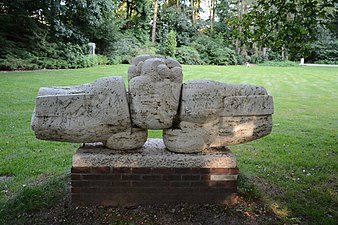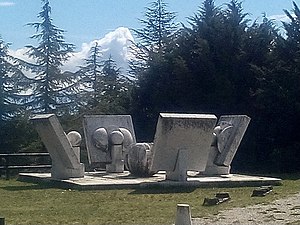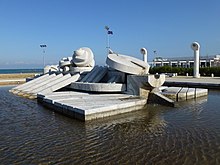Pietro Cascella
Pietro Cascella | |
|---|---|
 | |
| Born | February 2, 1921 Pescara, Italy |
| Died | May 18, 2008 |
| Nationality | Italian |
| Known for | |
| Spouse(s) |
|

Pietro Cascella (February 2, 1921 – May 18, 2008) was an Italian sculptor. His principal work consisted of large monumental sculptures, including the International Monument to the Victims of Fascism in the Auschwitz II-Birkenau death camp in Poland (1957–1967), and an underground mausoleum for Silvio Berlusconi at his villa in Arcore in the 1980s.[1][2]
Life[]
Cascella was born into a family of artists in Pescara on February 2, 1921. His father was Tommaso Cascella, a painter and ceramicist, and his mother was Susanna Federman.[2] His elder brother was a sculptor.[3][4][5][6] Two of his uncles were also artists, the painter Michele Cascella and painter and ceramicist , as was his grandfather, the painter, ceramicist, and lithographer Basilio Cascella.[2] In 1945 he married Anna Maria Cesarini Sforza, an artist.[1][7][8] From 1977 he lived with his second wife, , in the mediaeval in the comune of Fivizzano, above Carrara. He died in Pietrasanta in 2008.[9]
Work[]
In the late 1930s he moved to Rome and studied at the Accademia di Belle Arti under Ferruccio Ferrazzi, who taught both painting and sculpture.[2] He had work in the Quadriennale di Roma painting exhibition of 1943, and in the twenty-fourth Biennale di Venezia in 1948. He also participated in the 1957 Biennale almost ten years later.[2]
In the years after the Second World War Cascella, with his brother Andrea and various friends, worked in ceramics and mosaic in a brick-works in the , the brick-making district of Rome. In about 1949 he and his wife Cesarini Sforza were commissioned to create mosaics for the third-class waiting-room of the Stazione Termini, the principal railway station of Rome.[1][4] In 1950, the two completed a large mosaic for a Roman cinema, the .[10] At about this time he also made small-scale reliefs in various materials, some of them drawing inspiration from the work of Matta, who was a friend.[1]
In 1950–53, Cascella's ceramic work was included in the large American exhibition Italy at Work: Her Renaissance in Design Today.[11]
In 1962, his work was exhibited at the (Rome) in an exhibition of ceramics from that year. Also that year, he had a solo show at the (Milan). In 1965, he traveled to New York for a show organized by the . The following year, and again in 1972, he had a room at the Biennale. In 1968, his work was presented at the (Paris) and the (Bruxelles). In 1971, Cascella participated in the XXIII Salon de la Jeune Sculpture in Paris.[12]
In April 2006, Pietro Cascella was given the Medal of Merit for Culture and Art.[12]

Gateway of Peace, 1972, Tel Aviv, Israel

Nascita, 1973, Middelheim Open Air Sculpture Museum, Antwerp

Campo del Sole, various artists, 1985–1989, central sculpture; Tuoro sul Trasimeno, Umbria

Il Teatro della GerminazioneMonte Salviano, Abruzzo
References[]
| Wikimedia Commons has media related to Pietro Cascella. |
- ^ a b c d Christopher Masters (June 6, 2008). Pietro Cascella. The Guardian. Accessed June 2021.
- ^ a b c d e Carlo Maria d'Este (2015).Pietro Cascella (1921–2008) (in Italian). Regione Abruzzo – Dipartimento Turismo, Cultura e Paesaggio. Accessed June 2021.
- ^ Cascella, Pietro. Benezit Dictionary of Artists. Oxford: Oxford University Press. doi:10.1093/benz/9780199773787.article.B00033204. (subscription required).
- ^ a b Silvia Lucchesi (2003, updated 2009). Cascella, Pietro. Grove Art Online. Oxford: Oxford University Press. doi:10.1093/gao/9781884446054.article.T014558. (subscription required).
- ^ Franco Miracco (1991). Cascella, Pietro (in Italian). Enciclopedia Italiana, appendix IV. Roma: Istituto dell'Enciclopedia Italiana. Accessed June 2021.
- ^ Alexandra Andresen (1991). Cascella, Andrea (in Italian). Enciclopedia Italiana, appendix V. Roma: Istituto dell'Enciclopedia Italiana. Accessed June 2021.
- ^ "Cinema America, Cesarini Sforza: "Quando io e Pietro Cascella realizzammo i mosaici della sala"". la Repubblica (in Italian). June 18, 2014. Retrieved June 25, 2021.
- ^ "La firma di Pietro Cascella e Anna Maria Cesarini Sforza dietro i mosaici del Cinema America - Roma - Repubblica.it". Roma - La Repubblica. June 18, 2014. Retrieved June 25, 2021.
- ^ Cascèlla, Pietro (in Italian). Enciclopedie on line. Roma: Istituto dell'Enciclopedia Italiana. Accessed June 2021.
- ^ "«America», i mosaici di Cascella allontanano l'ipotesi demolizione". Corriere della Sera (in Italian). June 18, 2014. Retrieved June 25, 2021.
- ^ Rogers, Meyric (1950). Italy at Work: Her Renaissance in Design Today. Rome: Published for the Compagnia nazionale artigiana. p. 31.
- ^ a b Recinella, Walter (February 2, 2021). "2 Febbraio 1921 : i primi 100 anni di Pietro Cascella". Patronato ENASC (in Italian). Retrieved June 25, 2021.
- 1921 births
- 2008 deaths
- People from Pescara
- 20th-century Italian painters
- Italian male painters
- 21st-century Italian painters
- 20th-century Italian sculptors
- 20th-century male artists
- Italian male sculptors
- 21st-century Italian sculptors
- 21st-century male artists
- Italian contemporary artists
- Italian sculptor stubs




